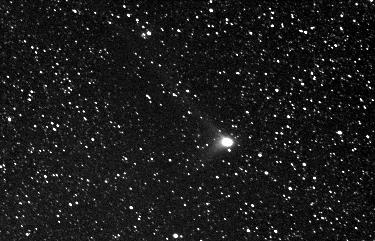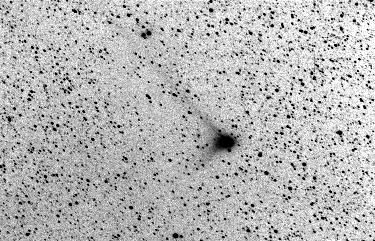« Reading List: Facing Up | Main | The Internet Slum: Is the Exodus Beginning? »
Tuesday, January 11, 2005
Comet Machholz Captured with CCD
A couple of days ago I configured my venerable SBIG ST-6 CCD camera to work with a spare laptop in the hope of being able to image the tails of Comet Machholz (C/2004 Q2) which had eluded me so far both visually and photographically. The greyscale sensor in the ST-6 is limited in size (only 375×241 pixels), but cooled to a temperature of -40°C by a Peltier junction, has extremely high quantum efficiency and low noise compared to general purpose digital cameras. The next few nights were either clouded out or sufficiently murky so the Milky Way wasn't even visible, but on the night of January 11th the temperature dropped to about 0°C and the sky became reasonably, if not perfectly, transparent, so I decided to give it a go. I used the same Nikon 50 mm f/1.4 lens with the CCD camera that I used for the pictures of the comet passing the Pleiades on the night of January 7-8, but stopped down to f/2.8 for better sharpness. After aiming the camera at the comet and the usual tedious focusing procedure (aided by recalling that with the lens adaptor for the CCD this lens is focused close to infinity when its focusing scale points to the decimal point in the "1.7 metre" mark), I experimented with exposures between 7 and 20 seconds and decided that 12 seconds was a reasonable compromise between integration time and minimising star trails on with the unguided tripod mount I was using.
The picture above is a 12 second exposure--the full CCD frame is shown. The image has been contrast stretched, but not otherwise processed. With the present geometry of the Sun, Earth, and comet, the ion tail (which extends toward the upper left in the image) and the stubby dust tail (toward the lower left) appear about 90° apart. The ion tail is entrained by the solar wind and acts like a weathervane pointing away from the Sun, while the dust tail follows the comet along its orbit.
January 7-8, but stopped down to f/2.8 for better sharpness. After aiming the camera at the comet and the usual tedious focusing procedure (aided by recalling that with the lens adaptor for the CCD this lens is focused close to infinity when its focusing scale points to the decimal point in the "1.7 metre" mark), I experimented with exposures between 7 and 20 seconds and decided that 12 seconds was a reasonable compromise between integration time and minimising star trails on with the unguided tripod mount I was using.
The picture above is a 12 second exposure--the full CCD frame is shown. The image has been contrast stretched, but not otherwise processed. With the present geometry of the Sun, Earth, and comet, the ion tail (which extends toward the upper left in the image) and the stubby dust tail (toward the lower left) appear about 90° apart. The ion tail is entrained by the solar wind and acts like a weathervane pointing away from the Sun, while the dust tail follows the comet along its orbit.
 The human eye generally finds it easier to spot subtle differences in shade in images of dark objects against a white background. Consequently, astronomers often show extended objects as inverted (negative) images. Here's an inverted and contrast stretched version of the captured image above. It shows that the coma extends well beyond the obvious white blob in the positive image and enhances the extent of the ion tail. In this comet, the ion tail is longer and more prominent than the dust tail; this isn't always the case: in
Hale-Bopp (C/1995 O1), the
two tails were of about equal length and intensity.
With the ambient temperature around freezing, the camera cooler had a less than usually challenging task keeping the sensor at its operating temperature, but the primate pushing the buttons found it a chilly experience indeed standing still in the cold-dark watching for each exposure to complete, download, and display. Also, I discovered that when the ends of your fingertips start to freeze, they no longer operate the touchpad on the laptop. A workaround is to lick them, move the cursor to where you want it, then scrape the ice off the end of the finger. Or, undoubtedly wiser, use a mouse.
The human eye generally finds it easier to spot subtle differences in shade in images of dark objects against a white background. Consequently, astronomers often show extended objects as inverted (negative) images. Here's an inverted and contrast stretched version of the captured image above. It shows that the coma extends well beyond the obvious white blob in the positive image and enhances the extent of the ion tail. In this comet, the ion tail is longer and more prominent than the dust tail; this isn't always the case: in
Hale-Bopp (C/1995 O1), the
two tails were of about equal length and intensity.
With the ambient temperature around freezing, the camera cooler had a less than usually challenging task keeping the sensor at its operating temperature, but the primate pushing the buttons found it a chilly experience indeed standing still in the cold-dark watching for each exposure to complete, download, and display. Also, I discovered that when the ends of your fingertips start to freeze, they no longer operate the touchpad on the laptop. A workaround is to lick them, move the cursor to where you want it, then scrape the ice off the end of the finger. Or, undoubtedly wiser, use a mouse.
Posted at January 11, 2005 23:53